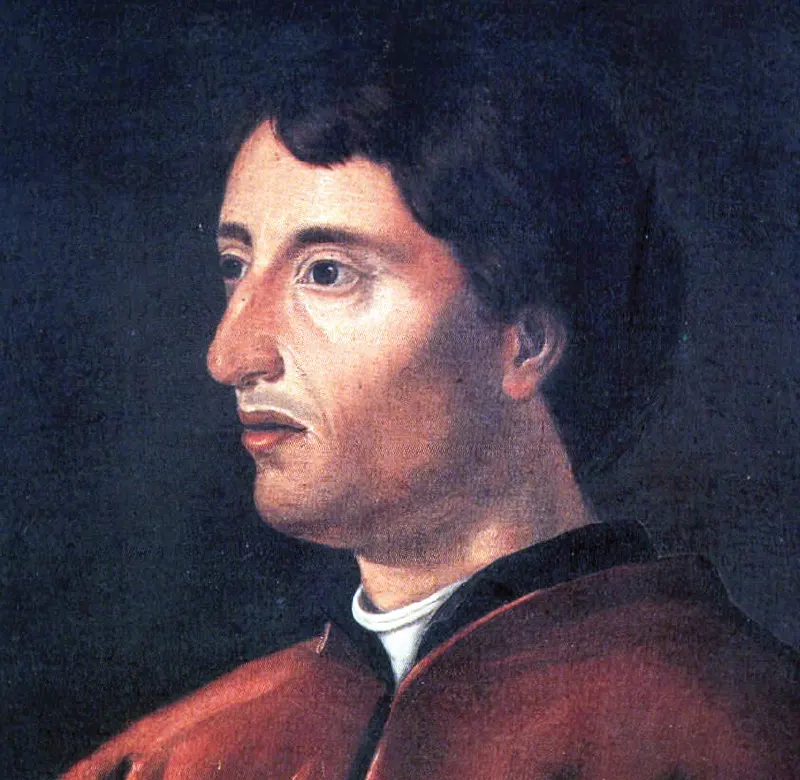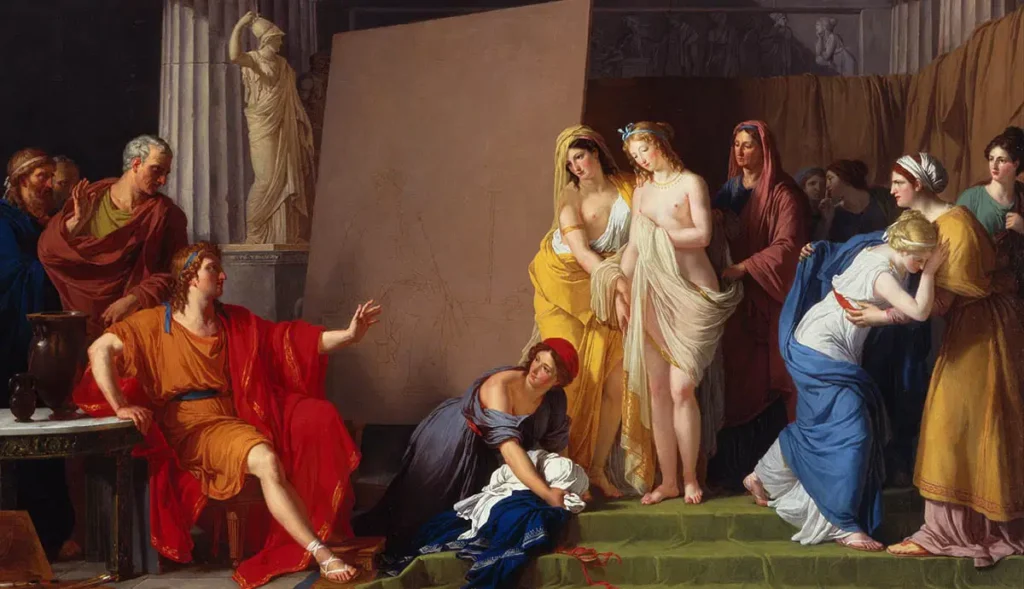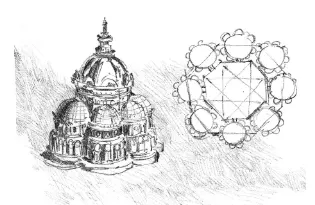Architecture and Art: Pioneers of Art and Architecture is the ninth article of a series1,2,3,4,5,6,7,8. Showing and analyzing the art dimension in architecture. This article analyzes the gradual development of art, art thinking, rules, and principles. In addition, the path of art development side by side with architecture and setting out rules for architecture. The article starts with an analysis of art and architecture development from the ancient world in Asia and Europe. Gradually the appearance of paintings and sculptures in Greece, byzantine, and Rome.
As I have discussed in the first article and the analysis of the beginning of art in the ancient world as basically in daily used tools and home appliances. People decorated the tools used in daily life such as pods, dishes, knives, and so on. Gradually, the craft of art has appeared in decorating home appliances. For example, chairs, sofas, tables, and even beds. Art craft men decorated not only wooden home appliances but also steel work of fences, items related to carriages of animals, and so on.
The second stage of artwork when painters started to paint on walls and decorating facades. The painting appeared in its simple forms and the existence of humans of 2d shapes. Painters gradually laid out the first rules of painting. Specifically, by putting together humans and landscapes on a wooden frame and white cloth representing the first form of painting. Figure 1 is a sample of the first type of painting showing the human in abstract form and clear background.
Pioneers of art and architecture, gradual development
Painters gradually gathered human figures, landscapes, and environments to give the painting a more realistic view. Moreover, these paintings also had the same character of 2d shapes. At the same time, with all types of environments and simulating nature in colors. At this specific time, all painters and sculptors worked by artistic instinct.
Art people were commissioned to conduct artwork in religious, public, and even private buildings. Also, decorating walls and ceilings, and sculptors to add statues in various areas. This type of work turned their attention to the 3d features of art in painting and sculpture. Sculptors specifically allocated more time to thinking of the 3d dimension in art. Furthermore, sketching and painting as they do both painting and sculpture.
Paintings appeared with depth, shade, and shadow, gave the paintings a more realistic view. Paintings of nature became more attractive and attracted public figures and important people in society. Therefore, these people commissioned painters to draw paintings and carve sculptures for their homes, public buildings, and religious buildings. Figure 2, a painting of Zeuxis (Athena) from the fifth century, shows how paintings and painters included the basic elements of design in art.
Because of the growing need for visualizing building forms, commissioned to painters, sculptors, and master builders led to the establishment of principles of sketching elevations and plans. Phidias is a sculptor and was responsible for all the artistic work in the temple painting and sculpture of the Parthenon. Similarly, others added their artistic views on temple design. The facades of the series of columns designed by the painters and sculptors had their proportional shape and volume set out by them. Here appeared the first pioneers of art and architecture.
Likewise, this gradual development of preparing drawings for buildings with the existence of master builders led to another development in art and sculpture. Painters and sculptors set out studies for 3d drawings and buildings perspective. In addition, this development led to setting out perspective drawing principles. As a result, painters and sculptors became more involved in the architectural design of various buildings in Greece and Rome. See 3d sketches by da Vinci for a chapel, see Figure 3.
The ancient Greek painters and sculptors had a direct role in establishing the art elements and design principles used in architecture. Furthermore, Sculptors developed the design of the basic principles of Greek architecture, the column orders.
Pytheos, and Hermogenes Greek sculptors, and architects developed and designed the ionic column order. In their work of designing Greek temples and the use of elements of design and principles of design in art, they set out the rules for architectural design.
Callimachus is a Greek sculptor and architect who developed and designed the Corinthian column order. Through the use of this column order and his temple’s design, he established the rules of using elements of design and principles of design in art in architecture.
The first Greek-Roman contribution, although not directly involved in art and architecture but civil work was Vitruvius’s ten books of architecture. In fact,the books remained a reference for setting out rules of building construction and aesthetic principles. These books were written in the Greek period 100 B.C. He mentioned in his books the role and the invention of the column orders in Greek architecture. Also, he pointed to Callimachus, the sculptor mentioned above. Here began the second group of pioneers in art and architecture.
Turning to the Roman period- Renaissance. Certainly, many painters and sculptors established from the elements of design and principles of design in art rules and design guidelines in architecture. Filippo Brunelleschi is a Renaissance Italian goldsmith, architect, sculptor, and painter. He had various studies on linear perspective drawings that other painters used to draw paintings. He also had many studies in related fields. Such as building construction, functional design, architecture structural forms, proportion systems, and decorative elements. His studies were the base and inspired others to develop other studies in the same fields. See Figure 4, Brunelleschi Figure 1377 Florence.

Michelozzo was a student of Brunelleschi who continued his architecture work after his death, he was a sculptor and architect. Through the various commissions for buildings in Italy, he is the innovator and the developer of the early Renaissance architecture style.
pioneers of art doing architecture design
Alberti was an Italian author, artist, architect, poet, priest, linguist, philosopher, and cryptographer. He was commissioned to design many buildings in Italy, he was famous for applying the golden section in architecture. Moreover, he wrote various publications in math and architecture. His book “On the Art of Building” was the first Renaissance architecture treatise. That includes subjects such as engineering, history, town planning, and aesthetics. See Figure 5 Alberti Genoa 1404.

Sangallo was an Italian sculptor, architect, and military engineer. His work on art developed advanced skills in architecture design based on art principles. He is famous for developing a book that contains sketches of architecture. In addition, detailing, architectural features like domes, and his studies of architectural buildings from other cities. The book is Sangallo’s Sienese sketchbook.
Raphael was an Italian painter and architect who designed many buildings in Rome translating his art principles into architectural rules and guidelines of architecture design.
Michelangelo and Leonardo da Vinci were painters, sculptors, and architects from Italy. These two with their colleague Alberti were considered the most influential art people in Italy for their contribution to art, architecture, and sculpture. The two conducted many studies in different fields such as engineering, proportion in architecture, and painting, adding to those studies on the architectural form of buildings. The two issued sketches and sketchbooks including detailing, architecture form, proportion studies, and perspective drawings.
Pioneers of art and architecture in Greece and Rome had a direct influence in establishing and paving the road to formal architecture academic study. The establishment of applying the elements of design, and the principle of design in art in architecture led to the development of not only architecture design but art development. The continual studies of architecture detailing, building forms and relationships, building construction techniques and methods, and the gradual development of architecture functional design laid and set out the guidelines of architecture study and training.
The formal architecture study and training in the modern world do not differ a lot from what the pioneers of art had set out in their study of art and architecture. The beginning of architecture study focuses on elements of design and principles of design in art and how to use them in architecture design of simple architecture. Training the student on developing sketching, hand drawing, and using color in 2d design and 3d design.
The consequent years focus on the construction of a building, its materials, techniques, and methods. Functional relationships related to building type, the study of building forms and relationships. Focus on architecture detailing of compound materials and preparing the detailed drawings.



Good post! We will be linking to this particularly great post on our site. Keep up the great writing